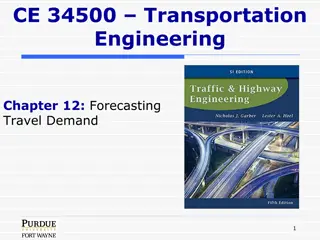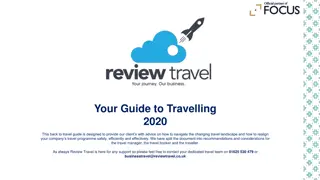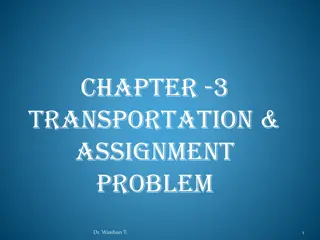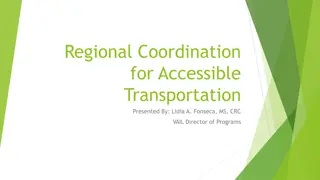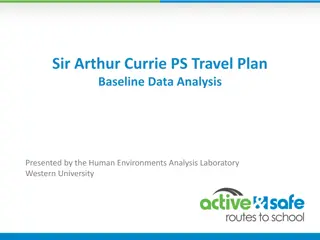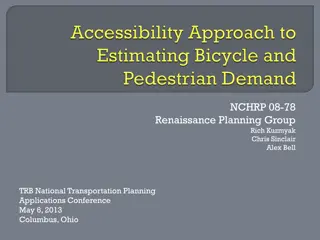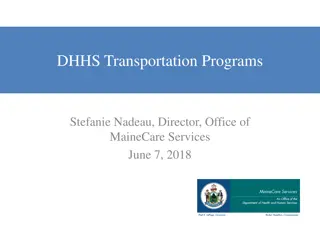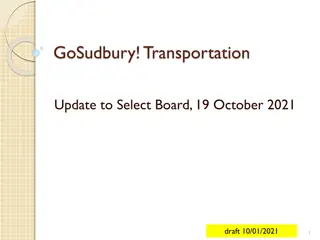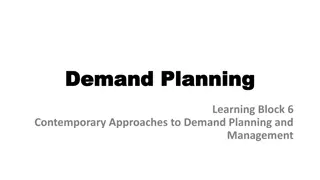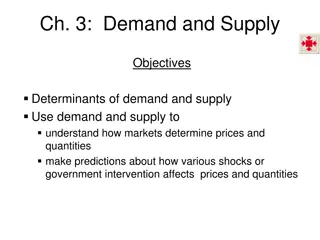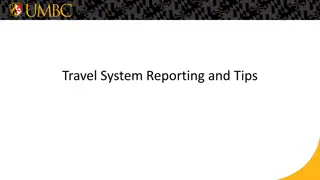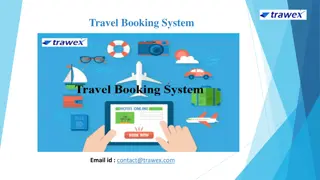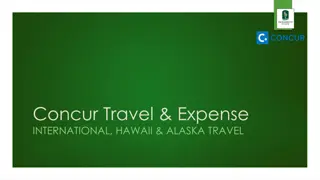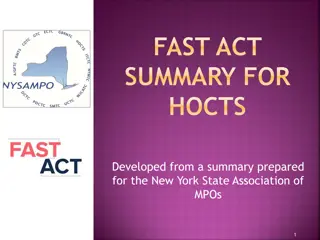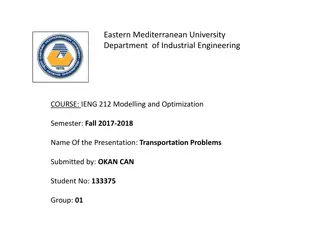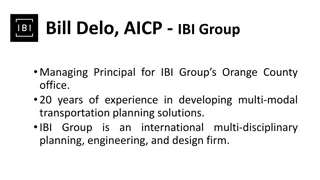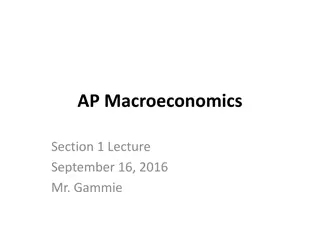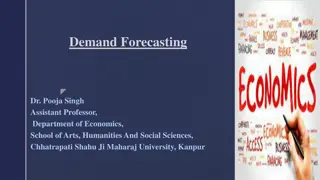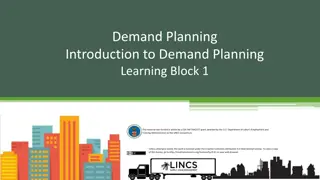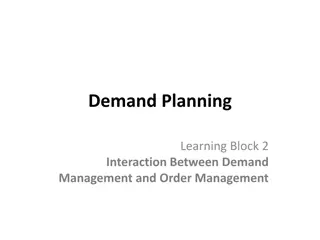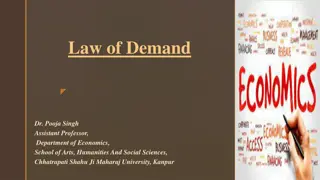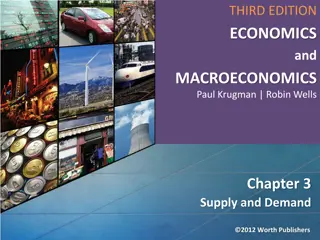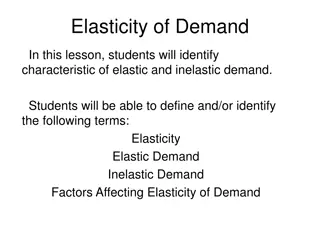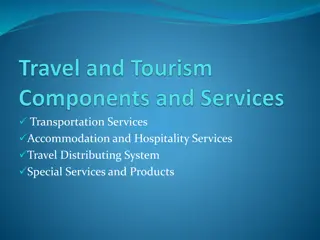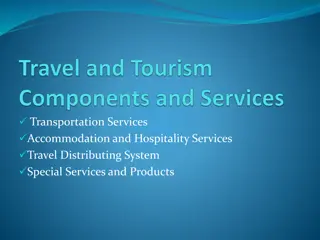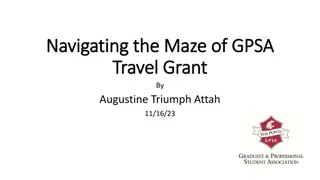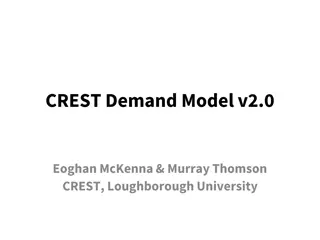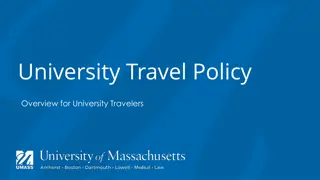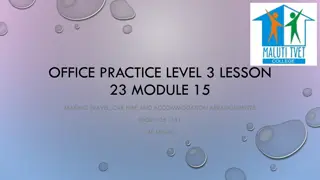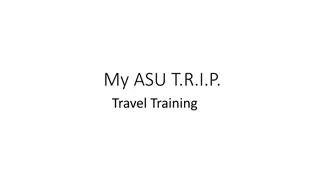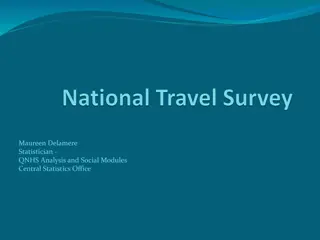Understanding Travel Demand Models in Transportation Planning
Travel Demand Models play a crucial role in transportation planning by mathematically describing relationships among transportation systems and socioeconomic factors. This lesson provides an overview of travel demand modeling, including basic elements of a model, modeling steps, and advanced topics such as population synthesis and joint travel data usage. The content also covers the four steps of travel demand models and concludes with a quiz to reinforce learning.
- Transportation Planning
- Travel Demand Models
- Modeling Workshop
- Traffic Forecasting
- Transportation Systems
Download Presentation

Please find below an Image/Link to download the presentation.
The content on the website is provided AS IS for your information and personal use only. It may not be sold, licensed, or shared on other websites without obtaining consent from the author. Download presentation by click this link. If you encounter any issues during the download, it is possible that the publisher has removed the file from their server.
E N D
Presentation Transcript
LESSON 1 MODEL OVERVIEW 1
PART A WHAT IS A TRAVEL DEMAND MODEL? FSUTMS COMPREHENSIVE MODELING WORKSHOP 2
LESSON GOALS In this lesson, we will discuss: What is a model? Overview of each model step Types of model applications FSUTMS COMPREHENSIVE MODELING WORKSHOP 3
WHAT IS A TRAVEL DEMAND MODEL? Travel Demand Models are mathematical descriptions of relationships among transportation system and socioeconomic characteristics (including traffic volumes, land use, roadway type and population and economic activity) Transportation planners use terms modeling and forecasting interchangeably ( Travel Demand Modeling or Travel Demand Forecasting ) FSUTMS COMPREHENSIVE MODELING WORKSHOP 4
BASIC ELEMENTS OF A MODEL Travel Demand Models include: The Model equations and data which reflect travel behavior The Software platform to implement these equations and interact with data FSUTMS COMPREHENSIVE MODELING WORKSHOP 5
BASIC MODELING STEPS Most classical travel demand models are structured around four sequential steps: 1. Trip Generation (How many trips?) 2. Trip Distribution (Where do the trips go?) 3. Mode Choice (Which mode of travel?) 4. Trip Assignment (What route?) FSUTMS COMPREHENSIVE MODELING WORKSHOP 6
ADVANCED MODELING TOPICS Population Synthesis Simulate each person in region Developed from micro sample (PUMS etc.) Tours Time of Day (Simulation of Departure Times) Joint Travel Use of probe and GPS device data to supplement surveys FSUTMS COMPREHENSIVE MODELING WORKSHOP 7
QUIZ #1 What makes a travel demand model different from other models? Travel demand models: A. Are used to forecast traffic data B. Are used to forecast socioeconomic data C. Earn income by being the object of interest for an artist s painting D. Earn income by appearing in promotional pictures wearing merchandise (usually clothing) from a manufacturer E. None of the above FSUTMS COMPREHENSIVE MODELING WORKSHOP 9
QUIZ #1 - ANSWER What makes a travel demand model different from other models? Travel demand models: A. Are used to forecast traffic data B. Are used to forecast socioeconomic data C. Earn income by being the object of interest for an artist s painting D. Earn income by appearing in promotional pictures wearing merchandise (usually clothing) from a manufacturer E. None of the above FSUTMS COMPREHENSIVE MODELING WORKSHOP 10
PART B FOUR STEPS OF TRAVEL DEMAND MODELS FSUTMS COMPREHENSIVE MODELING WORKSHOP 11
TRIP GENERATION HOW MANY TRIPS? Trip Generation estimates the number of trips produced by and attracted to each traffic analysis zone (TAZ) within a study area, based on socioeconomic characteristics (i.e., population and employment) of each zone FSUTMS COMPREHENSIVE MODELING WORKSHOP 12
TRIP GENERATION EXAMPLE SFDU MFDU 1 xxx xxx 2 xxx xxx 3 xxx xxx Household and Population Zone Data TRIP GENERATION Adjusted EMPLOYMENT 1 xxx xxx xxx 2 xxx xxx xxx 3 xxx xxx xxx TAZ PRODS ATTRS PRODS ATTRS 1 XXXX XXXX XXXX XXXX Employment Zone Data 2 XXXX XXXX XXXX XXXX 3 XXXX XXXX XXXX XXXX SPECIAL GENERATORS 2 xxx xx xxx xx 3 xxx xx xxx xx 13 Special Generator Zone Data
TRIP DISTRIBUTION WHERE TO? Trip Distribution determines the number of trips between each pair of zones in a model based on the magnitude of each zone s land uses and travel times between zones. FSUTMS COMPREHENSIVE MODELING WORKSHOP 14
TRIP DISTRIBUTION EXAMPLE Person Trip Table Adjusted Productions TO TAZ 1 2 3 TRIP 1 XXXX XXXX XXXX DISTRIBUTION FROM 2 XXXX XXXX XXXX Adjusted Attractions 3 XXXX XXXX XXXX FSUTMS COMPREHENSIVE MODELING WORKSHOP 15
MODE CHOICE WHICH MODE OF TRAVEL? Mode Choice calculates which trips will use the highway network with single- or multiple occupant vehicles versus those using the transit network (and in some models which trips will use non-motorized transport). FSUTMS COMPREHENSIVE MODELING WORKSHOP 16
MODE CHOICE EXAMPLE Person Trip Table MODE CHOICE Vehicle* Trip Table Transit Trip Table TO TO TAZ 1 2 3 TAZ 1 2 3 1 XXXX XXXX XXXX 1 XXXX XXXX XXXX FROM FROM 2 XXXX XXXX XXXX 2 XXXX XXXX XXXX 3 XXXX XXXX XXXX 3 XXXX XXXX XXXX *Highway Only (Auto Occupancy Model) FSUTMS COMPREHENSIVE MODELING WORKSHOP 17
TRIP ASSIGNMENT WHAT ROUTE? Trip Assignment models predict routes that trips will take, accounting for diversion caused by traffic congestion. The assignment model produces traffic forecasts for the highway system and ridership forecasts for the transit system. FSUTMS COMPREHENSIVE MODELING WORKSHOP 18
TRIP ASSIGNMENT EXAMPLE Vehicle Trip Table TRIP ASSIGNMENT Loaded Highway Network Network Link Volumes xxx xxx xxx xxx xxx xxx xxx xxx xxx From Node To Node Volume xxx xxx xxx xxx 1001 1002 XXXX xxx xxx xxx xxx xxx xxx xxx xxx xxx xxx xxx xxx 1001 1003 XXXX xxx xxx xxx xxx xxx xxx xxx xxx 1002 1004 XXXX xxx xxx xxx xxx xxx xxx FSUTMS COMPREHENSIVE MODELING WORKSHOP 19
QUIZ #2 1. Which step of the four-step modeling process determines where the trips go? 2. Which step of the four-step modeling process determines the mode of travel? 3. What are the other two steps of the four-step modeling process? 4. Is the trip generation rate for single family households part of the model or is it software? FSUTMS COMPREHENSIVE MODELING WORKSHOP 20
QUIZ #2 ANSWERS 1. Which step of the four-step modeling process determines where the trips go? Trip Distribution 2. Which step of the four-step modeling process determines the mode of travel? Mode Choice 3. What are the other two steps of the four-step modeling process? Trip Generation & Trip Assignment 4. Is the trip generation rate for single family households part of the model or is it software? Part of the model FSUTMS COMPREHENSIVE MODELING WORKSHOP 21
PART C USES AND TYPES OF MODELS FSUTMS COMPREHENSIVE MODELING WORKSHOP 22
USES OF TRAVEL DEMAND MODELS MPO Plan Updates Comprehensive Plans SIS/FIHS Planning Campus Master Plans Concurrency Applications Congestion Management Systems Corridor Studies Air Quality Analyses Freight Studies ITS Evaluation Strategies Project Development & Environment (PD&E) Studies Interchange Justification/Modification Reports (IJR/IMR) Developments of Regional Impact (DRIs) Toll Feasibility Studies FSUTMS COMPREHENSIVE MODELING WORKSHOP 23
TYPES OF MODELS BY GEOGRAPHY Urban Area Models One MPO Regional Planning Models At least more than one county and possibly more than one MPO Statewide Models Entire state, used to forecast freight and intercity travel FSUTMS COMPREHENSIVE MODELING WORKSHOP 24
TYPES OF MODELS BY MODE Highway Vehicle Models Only includes highway mode of travel; mode choice is only related to auto occupancy Transit Models Model that includes mode choice and transit networks Freight or Truck Models Model that includes estimates of truck trips and possibly freight flows FSUTMS COMPREHENSIVE MODELING WORKSHOP 25
QUIZ #3 List two uses of travel demand models. What type of model would be used to forecast 2045 traffic in Gainesville for its LRTP? What type of model would produce cargo tonnage forecasts along a corridor for rail, coastal shipping and trucks? I need I-75 forecast data for 2040 in a rural area in Columbia County; which type of model would I use? The Miami-Dade Transit Metrorail system is planned to be expanded. Can the South Florida Regional Planning Model (SERPM) to study alternatives be described as having a transit component? FSUTMS COMPREHENSIVE MODELING WORKSHOP 26
QUIZ #3 ANSWERS List two uses of travel demand models. Freight studies, MPO plan updates What type of model would be used to forecast 2045 traffic in Gainesville for its LRTP? Urban Area Model What type of model would produce cargo tonnage forecasts along a corridor for rail, coastal shipping and trucks? Freight Model I need I-75 forecast data for 2040 in a rural area in Columbia County; which type of model would I use? Statewide Model The Miami-Dade Transit Metrorail system is planned to be expanded. Can the South Florida Regional Planning Model (SERPM) used to study alternatives be described as having a transit component? Yes FSUTMS COMPREHENSIVE MODELING WORKSHOP 27
END OF LESSON 1, PART C FSUTMS COMPREHENSIVE MODELING WORKSHOP 28


